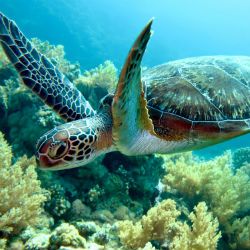Sea Turtles Take A Shorter Route Around The Atlantic

The path travelled by baby sea turtles may not correspond with what scientists had assumed until now. In fact according to satellite tracking some of the turtles actually opt for warmer browner pastures.
Until recently scientists have believed that young sea turtles hop on the back of a big sea current called the North Atlantic Subtropical Gyre which should take them all the way around the ocean and helping them turn up on their original coastline after one or two years. The first study conducted using satellite technology shows that many young turtles drop out of the current and choose to follow brown floating seaweed known as Sargassum which provides food, shelter and heat.
Lost years
The first few years in the life of a sea turtle are often referred to as “the lost years”. Whilst the hatchlings are easy to count when they are first born, as soon as they hit the sea for the first time they vanish for several years. The loggerhead turtle for example disappears when they are smaller than the size of a hand palm and then reappears at the same coast where they hatched and measure a foot and a half.
Turtles are born with a magnetic sense of direction which guides their migrations according to previous research. Marine biologists usually track sea animals using satellite tags that transmit data such as temperature, depth and locations. However the problem with hatchlings is they are too small to tag and would sink due to the heavy batteries.
Tagging turtles
Recent advances in technology has brought significant change. The latest tags are much smaller and rely on solar power instead of heavy batteries. Whilst they are still too large to tag newly born turtles, they do fit on young ones. Scientists reared 17 loggerhead turtles in the lab for up to 9 months until they reached between 4 to 7 inches in length And then tagged them for release into the Atlantic Ocean.
The assumption was that baby turtles would hatch of the East Coast of the US and then hop on the gulf stream which would take them North where they would eventually reach the Atlantic Subtropical Gyre. This is in actual fact a system of currents which should take the baby turtles past the Azores of Western Europe, down Africa’s coast and finally back to the East Coast of the US.
Whilst the turtles do make use of the Gulf Stream and the Gyre they do not always complete this journey around the Atlantic. Some turtles travelled clockwise taking their own individual paths whilst some even dropped out of the Gyre altogether and followed the still Sargasso Sea instead.
According to the findings Saragassum offers a floating habitat for the baby turtles not only hiding them from predators but also keeping them warm and fed. The turtles that drop out may benefit by staying with the seaweed and travelling shorter distances.
The results of the study are important for protecting sea turtles with many subspecies critically endangered with the young in particular vulnerable to fishing and other human activities. The new study suggests damage to Sargassum habitats could hurt turtles, too.



